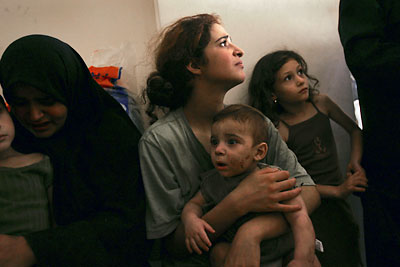 From The Tattooing Monks of Wat Bang Phro-Copyright 2005 Tewfic El-Sawy
From The Tattooing Monks of Wat Bang Phro-Copyright 2005 Tewfic El-SawyFor this week's
Beyond The Frame feature, I chose my image of a Thai being tattooed, his skin being pulled tautly by his friends.
I had heard of a monastery not far from Bangkok that specialized that had the best tattooing artists in Thailand. These artists were Buddhist monks who worked virtually around the clock, tattooing religious designs on Thais and the occasional foreigner.
With a taxi driver who seemed to know how to get to Wat Bang Phro, and about half an hour of frenetic driving, we got to the monastery. Before allowed in, I was first interviewed by a senior monk who wanted to be reassured that I did not intend to defame the practice in any way. Allowed then to photograph as I pleased, I walked in a room where two monks were busy. They used long metal rods, sharpened to a fine point, and had uncanny precision in their work. I watched in disbelief how fast the monk's hand moved...it was just a blur. Here, antiseptics range from regular rubbing alcohol to a local rice wine, and toilet paper paper to blot any blood. I was told that the ink was made from snake venom, herbs, and cigarette ashes. The monks' talents as tattoo artists are available for an offering of orchids, a carton of Thai cigarettes (preferably menthol-flavored) or perhaps a few Bhats towards the upkeep of the Wat.
The tattoos, as inscribed by these Buddhist monks, are defensive in purpose since they are to protect the wearer from any harm. Here in Thailand, tattoos are considered by many to have powerful powers, and to prevent bad luck in general.
It was quite difficult to find a good spot to photograph in this room. The sunlight came through two windows, but the corners of the room were dark, and I couldn't ask the monks and their 'clients' to hold a pose. This was purely a situation where one photographs as one can, irrespective of angles. I was on top of them, to their side...anywhere I could find some space.
EXIF: shutter speed 1/13 sec.- fstop 5.6 - iso 200 - focal length 28mm - no flash fired.











